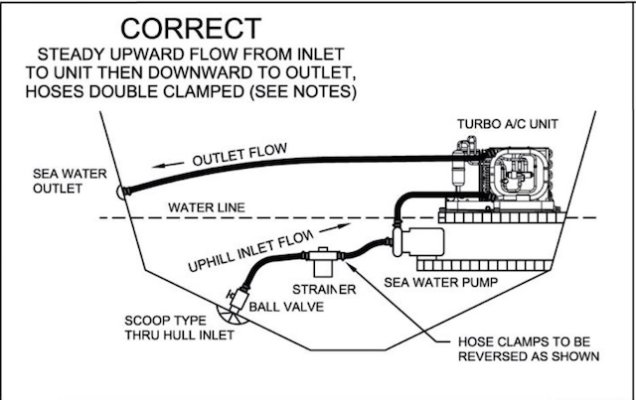Serene
Senior Member
I am in the process of planning a new installation of a self-contained marine A/C unit but have a question about location. I have read numerous product installation manuals and looked at installation diagrams, but cannot find an answer.
My question is, can the unit be placed below the waterline?
Every diagram I have found looks like the attached. i.e. the A/C unit is always above the waterline, with a constant rise on the raw water intake side and a fall on the water output side. But, when reading the installation manuals, it is suggested the units can be placed under a V-Berth. However this to me would most likely be below the waterline.
In my installation I need to cool the an above deck saloon area as well as two below deck cabins, both in the forecastle. I would like to select a single A/C unit with two outputs and place it under the queen berth, with ducting running forward to output under the V-Berth, which would direct cold air backwards. The second outlet would be run into the saloon and output under the settee, directing air forward.
The return air would be underneath the queen berth in the cabin between the V-Berth cabin and the saloon, which I would expect help airflow to circulate and draw air into the queen cabin.
But this would mean the unit is mounted below the waterline.
Is this possible?
If so, how does the water outlet drain when it has to run uphill?
Or, is the key here the seawater pump. i.e. the pump provides enough pressure to push the raw water through the A/C unit and uphill to exit above the waterline?
My question is, can the unit be placed below the waterline?
Every diagram I have found looks like the attached. i.e. the A/C unit is always above the waterline, with a constant rise on the raw water intake side and a fall on the water output side. But, when reading the installation manuals, it is suggested the units can be placed under a V-Berth. However this to me would most likely be below the waterline.
In my installation I need to cool the an above deck saloon area as well as two below deck cabins, both in the forecastle. I would like to select a single A/C unit with two outputs and place it under the queen berth, with ducting running forward to output under the V-Berth, which would direct cold air backwards. The second outlet would be run into the saloon and output under the settee, directing air forward.
The return air would be underneath the queen berth in the cabin between the V-Berth cabin and the saloon, which I would expect help airflow to circulate and draw air into the queen cabin.
But this would mean the unit is mounted below the waterline.
Is this possible?
If so, how does the water outlet drain when it has to run uphill?
Or, is the key here the seawater pump. i.e. the pump provides enough pressure to push the raw water through the A/C unit and uphill to exit above the waterline?

